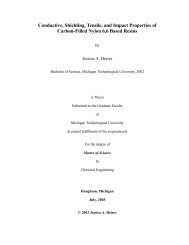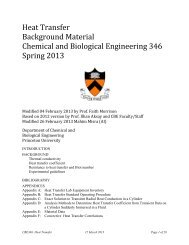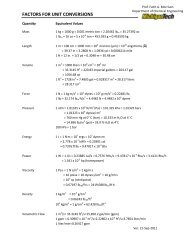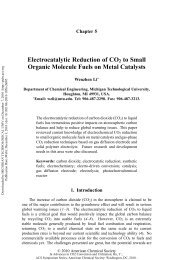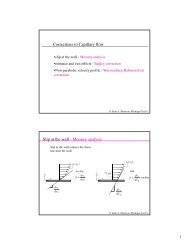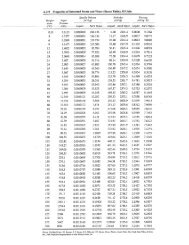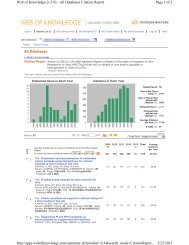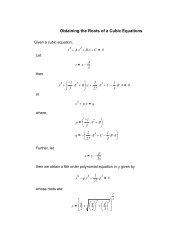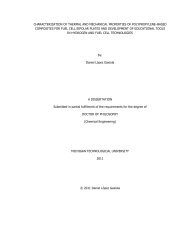A study on vortex shedding from spheres in uniform flow
A study on vortex shedding from spheres in uniform flow
A study on vortex shedding from spheres in uniform flow
You also want an ePaper? Increase the reach of your titles
YUMPU automatically turns print PDFs into web optimized ePapers that Google loves.
H. Sakamoto<br />
H. Haniu<br />
Department of Mechanical Eng<strong>in</strong>eer<strong>in</strong>g,<br />
Kitami Institute of Technology,<br />
Hokkaido, 090 Japan<br />
A Study <strong>on</strong> Wortex Shedd<strong>in</strong>g From<br />
Spheres <strong>in</strong> a Uniform Flow<br />
Vortex <strong>shedd<strong>in</strong>g</strong> <strong>from</strong> <strong>spheres</strong> at Reynolds numbers <strong>from</strong> 3Y.10 2 to 4Y.10 4 <strong>in</strong> a<br />
<strong>uniform</strong> <strong>flow</strong> was <strong>in</strong>vestigated experimentally. Standard hot-wire technique were<br />
used to measure the <strong>vortex</strong> <strong>shedd<strong>in</strong>g</strong> frequency <strong>from</strong> <strong>spheres</strong> <strong>in</strong> a low-speed w<strong>in</strong>d<br />
tunnel. Flow-visualizati<strong>on</strong> experiments were carried out <strong>in</strong> a water channel. Important<br />
results <strong>from</strong> the <strong>in</strong>vestigati<strong>on</strong> were that (i) the variati<strong>on</strong> of the Strouhal<br />
number St( =fD/U 0 , U 0 : freestream velocity, D: diameter of the sphere, f: <strong>vortex</strong><br />
<strong>shedd<strong>in</strong>g</strong> frequency) with the Reynolds number (= U(,D/v, v: k<strong>in</strong>ematic viscosity)<br />
can be classified <strong>in</strong>to four regi<strong>on</strong>s, (ii) the Reynolds number at which the hairp<strong>in</strong>shaped<br />
vortices beg<strong>in</strong> to change <strong>from</strong> lam<strong>in</strong>ar to turbulent vortices so that the wake<br />
structure beh<strong>in</strong>d the sphere is not shown clearly when a Reynolds number of about<br />
800 is reached, and (vi) at Reynolds numbers rang<strong>in</strong>g <strong>from</strong> 8X10 2 to 7.5 x 10 4 , the<br />
higher and lower frequency modes of the Strouhal number coexist.<br />
1 Introducti<strong>on</strong><br />
Wakes beh<strong>in</strong>d a sphere are encountered so frequently <strong>in</strong><br />
eng<strong>in</strong>eer<strong>in</strong>g applicati<strong>on</strong>s that large amounts of research have<br />
been c<strong>on</strong>ducted and massive amounts of data have been accumulated.<br />
Many reports which c<strong>on</strong>cern <strong>on</strong>ly the <strong>vortex</strong> <strong>shedd<strong>in</strong>g</strong><br />
frequency <strong>from</strong> a sphere have been published. Moller<br />
(1938) has measured the frequency of <strong>vortex</strong> <strong>shedd<strong>in</strong>g</strong> <strong>from</strong> a<br />
sphere by <strong>flow</strong>-visualizati<strong>on</strong> <strong>in</strong> the Reynolds number range of<br />
10 3
J.<br />
~T~<br />
Hot-Wire<br />
Support<strong>in</strong>g Wire<br />
Sphere/<br />
6 B m3 2 4 6 8 ,„/. 2 4 6<br />
,U l0<br />
Re<br />
Fig. 3 Various data tor Strouhal number of sphere [1-8]<br />
Fig. 4 Distributi<strong>on</strong> of low-mode and high-mode Strouhal number versus<br />
Reynolds number. (Uncerta<strong>in</strong>ty <strong>in</strong> St: less than ± 3.5 percent, <strong>in</strong> Re: less<br />
than ± 2 percent.)<br />
2.4 Measurement of Frequency. The frequency of <strong>vortex</strong><br />
<strong>shedd<strong>in</strong>g</strong> <strong>from</strong> the sphere placed <strong>in</strong> the w<strong>in</strong>d tunnel was determ<strong>in</strong>ed<br />
<strong>on</strong> the basis of the power spectrum analysis of the<br />
fluctuat<strong>in</strong>g velocity detected by a hot-wire probe mounted <strong>in</strong><br />
the wake beh<strong>in</strong>d the sphere. The positi<strong>on</strong> of the hot-wire probe<br />
(which was somewhat dependent <strong>on</strong> the Reynolds number) was<br />
determ<strong>in</strong>ed by observ<strong>in</strong>g visualized patterns <strong>in</strong> the wake; it<br />
was <strong>in</strong> the range of (3 to A)D <strong>from</strong> the rear surface of the<br />
sphere. In order to avoid any <strong>in</strong>fluence <strong>from</strong> the hot-wire probe<br />
<strong>on</strong> the wake characteristics of the sphere, the pr<strong>on</strong>gs were made<br />
of p<strong>in</strong>o-wire with a tip diameter of about 0.1mm and a length<br />
of 60mm; they were bent to a 135 degree angle and both ends<br />
of the hot wire were soldered of them. Also, the <strong>vortex</strong> <strong>shedd<strong>in</strong>g</strong><br />
frequency of the sphere mounted <strong>in</strong> the water channel was<br />
determ<strong>in</strong>ed by measur<strong>in</strong>g the time necessary for a sequence of<br />
fifty vortices to be shed.<br />
3 Results and Discussi<strong>on</strong>s<br />
Figure 3 shows the ma<strong>in</strong> results that have been reported<br />
c<strong>on</strong>cern<strong>in</strong>g the Strouhal number of a sphere St( =fD/U 0 , where<br />
/is the frequency of the <strong>vortex</strong> <strong>shedd<strong>in</strong>g</strong>, and D the diameter<br />
of the sphere). The hairp<strong>in</strong>-shaped vortices beg<strong>in</strong> to be periodically<br />
shed when the Reynolds number reaches about<br />
Re = 350 ~ 400 (about Re = 300 <strong>in</strong> the present experiment). The<br />
values of these Strouhal numbers up to Re=10 3 are almost<br />
the same as those previously recorded except for those obta<strong>in</strong>ed<br />
by Magarvey and Bishop (1961). In the range of the Reynolds<br />
numbers between 10 3 and 10 4 , two Strouhal numbers exist,<br />
namely, the high-mode and low-mode Strouhal number. The<br />
high-mode Strouhal number obta<strong>in</strong>ed by Moller (1938) exists<br />
up to Re=10 4 , but Cometta's result (Cometta, 1957) exists<br />
<strong>on</strong>ly up to Re = 7.4xl0 3 ; these values are somewhat lower<br />
than those given by Moller. On the other hand, results obta<strong>in</strong>ed<br />
by Kim and Durb<strong>in</strong> (1988) show clearly that the two dist<strong>in</strong>ct<br />
modes exist simultaneously <strong>in</strong> the Reynolds number ranges of<br />
8x 10 2
the <strong>vortex</strong> sheet separated <strong>from</strong> the sphere surface, and <strong>in</strong><br />
accordance with its pulsati<strong>on</strong>, the cyl<strong>in</strong>drical vortices (def<strong>in</strong>ed<br />
as <strong>vortex</strong> tube <strong>in</strong> the present <str<strong>on</strong>g>study</str<strong>on</strong>g>) beg<strong>in</strong> to be periodically<br />
shed, cover<strong>in</strong>g the <strong>vortex</strong> formati<strong>on</strong> regi<strong>on</strong> as shown <strong>in</strong> Fig.<br />
6(a). The values for the Strouhal number determ<strong>in</strong>ed based<br />
<strong>on</strong> the frequency of the <strong>vortex</strong> tube <strong>shedd<strong>in</strong>g</strong> estimated <strong>from</strong><br />
the visual observati<strong>on</strong> are very similar to the high-mode St<br />
obta<strong>in</strong>ed by Moller (1938) and Achenbach (1974). This suggests<br />
o<br />
50<br />
(a) Re=\276<br />
100Hz 0<br />
o 100 200Hz 0<br />
(b) Re=4325 (d)<br />
500<br />
ec) Re =10890<br />
(v:414Hz)<br />
1000Hz<br />
(v: 633 Hz)<br />
Fig. 5 Power spectrum of fluctuat<strong>in</strong>g velocity based <strong>on</strong> <strong>vortex</strong> tube<br />
<strong>shedd<strong>in</strong>g</strong> (Uncerta<strong>in</strong>ty <strong>in</strong> Re: less than :!: 2 percent.)<br />
Fig. 6 Visualized observati<strong>on</strong> for wake beh<strong>in</strong>d sphere (a) Vortex tubes,<br />
(b) large-scale vortices. (Uncerta<strong>in</strong>ty In Re: less than :!: 2 percent.)<br />
that the high-mode St is based <strong>on</strong> the <strong>shedd<strong>in</strong>g</strong> of the <strong>vortex</strong><br />
tube generated by the pulsati<strong>on</strong>s of the <strong>vortex</strong> sheet. Also,<br />
when a hot-wire is placed <strong>in</strong> the extreme neighborhood of the<br />
sphere, the frequency of the <strong>vortex</strong> tubes shed <strong>from</strong> the sphere<br />
could be detected by the spectrum analysis of the fluctuat<strong>in</strong>g<br />
velocity as shown <strong>in</strong> Fig. 5. On this spectrum analysis of the<br />
fluctuat<strong>in</strong>g velocity, the frequency of the large-scale <strong>vortex</strong><br />
<strong>shedd<strong>in</strong>g</strong> which is c<strong>on</strong>siderably lower compared with that of<br />
the <strong>vortex</strong> tube is cut off by an analogue high-pass filter <strong>in</strong><br />
order to appear <strong>on</strong>ly as a prevail<strong>in</strong>g frequency based <strong>on</strong> the<br />
<strong>vortex</strong> tube. However, when the Re is larger than 1.5 X 10 4 <strong>in</strong><br />
the present experiment, no clear peak is observed by the spectrum<br />
analysis because the fluctuati<strong>on</strong> energy becomes extremely<br />
small. Furthermore, the energy level of the fluctuat<strong>in</strong>g<br />
velocity based <strong>on</strong> the <strong>shedd<strong>in</strong>g</strong> of the <strong>vortex</strong> tubes is much<br />
smaller than that based <strong>on</strong> wave moti<strong>on</strong> of the wake with<br />
alternate fluctuati<strong>on</strong>s as shown <strong>in</strong> Fig. 6(b). Accord<strong>in</strong>gly, it<br />
would be safe to c<strong>on</strong>sider that the unsteady <strong>flow</strong> around the<br />
sphere is ma<strong>in</strong>ly caused by the wave moti<strong>on</strong> of the wake with<br />
alternate fluctuati<strong>on</strong>s when the Re is larger than about 800.<br />
On the other hand, Kim and Durb<strong>in</strong> (1988) have found that<br />
the high-mode St exists <strong>in</strong> the wide range of the Reynolds<br />
numbers between 8 X 10 2 and 6 X 104, and then it is associated<br />
with the small scale <strong>in</strong>stability of the separat<strong>in</strong>g shear layer.<br />
However, they did not make clarificati<strong>on</strong>s c<strong>on</strong>cern<strong>in</strong>g the<br />
structure of the small scale <strong>in</strong>stability of the separat<strong>in</strong>g shear<br />
layer. Perhaps, it could be c<strong>on</strong>cluded that the <strong>vortex</strong> tube is<br />
formed by the small scale <strong>in</strong>stability of the separat<strong>in</strong>g shear<br />
layer.<br />
Figure 7 shows the Strouhal number based <strong>on</strong> the hairp<strong>in</strong>shaped<br />
<strong>vortex</strong> and the large-scale <strong>vortex</strong> <strong>shedd<strong>in</strong>g</strong> obta<strong>in</strong>ed by<br />
the hot-wire measurement, namely the low-mode St, with the<br />
Reynolds number. We classified these results <strong>in</strong>to regi<strong>on</strong>s I - VI<br />
and transiti<strong>on</strong>al regi<strong>on</strong>s A - C, tak<strong>in</strong>g <strong>in</strong>to account the change<br />
<strong>in</strong> the Strouhal number corresp<strong>on</strong>d<strong>in</strong>g to the Reynolds number.<br />
The follow<strong>in</strong>g is a rough descripti<strong>on</strong> of each regi<strong>on</strong> <strong>in</strong> terms<br />
of the relati<strong>on</strong>ship between its St and the c<strong>on</strong>figurati<strong>on</strong> of the<br />
wake.<br />
(i)Regi<strong>on</strong> 1(300 < Re< 420)<br />
Accord<strong>in</strong>g to Taneda's <strong>flow</strong>-visualizati<strong>on</strong> experiment <strong>in</strong> the<br />
range of 5< Re < 300 (Taneda, 1956), when the Re is over 130,<br />
fa<strong>in</strong>t periodic pulsative moti<strong>on</strong> with a very l<strong>on</strong>g period occurs<br />
at the rear ofthe <strong>vortex</strong>-r<strong>in</strong>g formed beh<strong>in</strong>d the sphere, form<strong>in</strong>g<br />
.26<br />
SI<br />
.24<br />
.22<br />
.20<br />
.18<br />
.16<br />
J<br />
°8~<br />
I III I I I I I I II<br />
(j) Regi<strong>on</strong> I (300
(.~) 130
1/5 T<br />
~<br />
215T<br />
~<br />
3/5 T<br />
M5T<br />
5/5 T<br />
~<br />
~<br />
(<br />
~ .<br />
Fig. 11 Shedd<strong>in</strong>g pattern of halrpln·shaped <strong>vortex</strong> with respect to <strong>on</strong>e<br />
period 50<br />
1501r0~----.-------,------r------,----<br />
F<br />
140<br />
120<br />
100<br />
80<br />
~ : No yortex <strong>shedd<strong>in</strong>g</strong><br />
regI<strong>on</strong><br />
T.R.: Tra[1siti<strong>on</strong>al<br />
regI<strong>on</strong><br />
Regi<strong>on</strong> IT<br />
velocity detected by CH 4 is much larger than the others; this<br />
suggests that the hairp<strong>in</strong>-shaped vortices <strong>flow</strong> out <strong>in</strong> <strong>on</strong>e directi<strong>on</strong><br />
<strong>from</strong> the po<strong>in</strong>t near where CH 4 is set. Moreover, the<br />
power spectrum as shown <strong>in</strong> Fig. 9(b) and the waveform of<br />
the fluctuat<strong>in</strong>g velocity as shown <strong>in</strong> Fig. lO(a) suggest that the<br />
hairp<strong>in</strong>-shaped vortices are periodically shed <strong>in</strong> what is called<br />
a regular mode with regularity <strong>in</strong> strength and frequency. This<br />
is perhaps because the energy entra<strong>in</strong><strong>in</strong>g <strong>in</strong>to the <strong>vortex</strong> formati<strong>on</strong><br />
regi<strong>on</strong> is very regularly supplied, stored and emitted,<br />
as is clearly shown by the <strong>shedd<strong>in</strong>g</strong> system of the <strong>vortex</strong> as<br />
shown <strong>in</strong> Fig. 11 (where Tis the time when <strong>on</strong>e <strong>vortex</strong> is shed).<br />
This also expla<strong>in</strong>s why the vortices shed <strong>in</strong> successi<strong>on</strong> are of<br />
the same strength and frequency.<br />
(ii) Transiti<strong>on</strong>al Regi<strong>on</strong> A (420
Vortex<br />
<strong>shedd<strong>in</strong>g</strong><br />
Orientati<strong>on</strong><br />
of the wake<br />
C<strong>on</strong>figurati<strong>on</strong><br />
of the wake<br />
Regi<strong>on</strong><br />
Reynolds<br />
number<br />
Table 1 Classificati<strong>on</strong> of <strong>vortex</strong> <strong>shedd<strong>in</strong>g</strong> pattern with respect to change<br />
of Reynolds number<br />
No <strong>vortex</strong><br />
<strong>shedd<strong>in</strong>g</strong><br />
Periodic <strong>vortex</strong> <strong>shedd<strong>in</strong>g</strong> No periodic 7<br />
<strong>vortex</strong> <strong>shedd<strong>in</strong>g</strong><br />
One Rot l<strong>in</strong>g I Irregular rotati<strong>on</strong> of the plane<br />
way|<br />
c<strong>on</strong>ta<strong>in</strong><strong>in</strong>g the wake<br />
Rotati<strong>on</strong> about<br />
strearnwise axis<br />
<strong>in</strong>g<br />
Wav<strong>in</strong>g wake<br />
Fixed <strong>vortex</strong> Vortex loop Vortex tube<br />
fi-shaped <strong>vortex</strong><br />
No <strong>vortex</strong><br />
/ <strong>shedd<strong>in</strong>g</strong> regi<strong>on</strong> 1 AI m<br />
I* 5 6 7 8 9.<br />
10 3 4 5 6 7 8 91n6<br />
hairp<strong>in</strong>-shaped <strong>vortex</strong> observed <strong>in</strong> the low Reynolds number<br />
regi<strong>on</strong> (Re < 800) whose model is shown <strong>in</strong> Fig. 8(d). Its structure<br />
has not yet been sufficiently clarified through detailed<br />
measurement c<strong>on</strong>cern<strong>in</strong>g the structure of the turbulent wake<br />
beh<strong>in</strong>d the sphere. Therefore, it would be desirable to c<strong>on</strong>t<strong>in</strong>ue<br />
the <strong>in</strong>vestigati<strong>on</strong> of the structure of the turbulent wake beh<strong>in</strong>d<br />
the sphere,<br />
(vi) Transiti<strong>on</strong>al Regi<strong>on</strong> C (3 x 10 3



